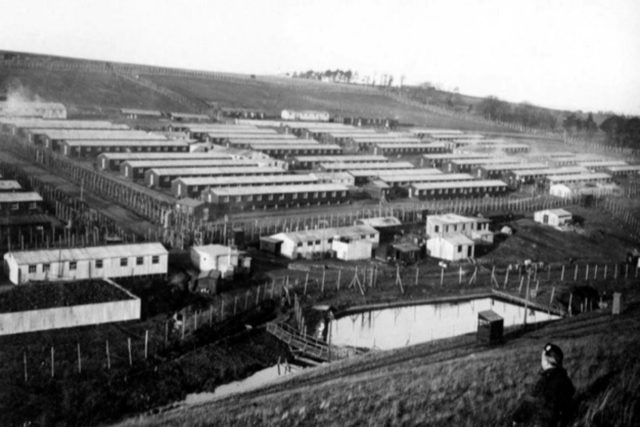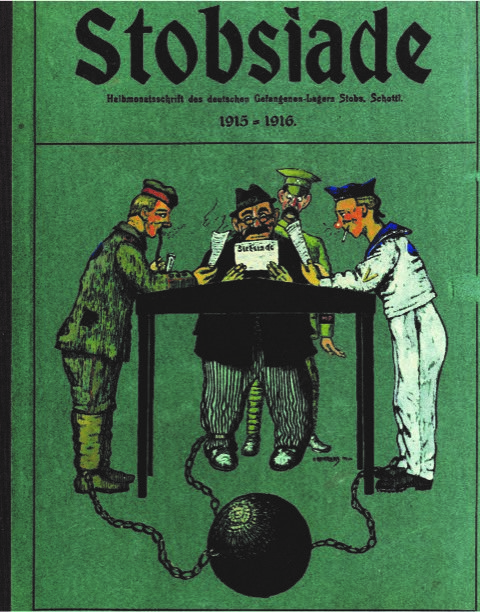
A new exhibition tells the story of the German “aliens” detained in their thousands at British camps during the First World War.
Stobs internment camp near Hawick in the Scottish Borders held around 4,500 civilians and military prisoners of war, the second largest of its kind in the Empire.
It features in Behind the Wire: Civilian Internment in the British Empire 1914-1919, an exhibition launched at Hawick Museum on Sunday.
Stobs is one of the best preserved camps and has become an important archaeological site which continues to offer insights into detention during the Great War.
A single hut remains, along with the foundations of several others, and a cairn in memory of those who died there is located by a cemetery.
 The camp as it once appeared (Collections of Scottish Borders Council administered by Live Borders/Hawick Museum)
The camp as it once appeared (Collections of Scottish Borders Council administered by Live Borders/Hawick Museum)
The exhibition will be shown in Ireland and South Africa, with plans to take it to Canada and New Zealand.
Researchers are meanwhile undertaking translations of German language texts that were produced by Stobs detainees. They include letters and a camp newspaper.
Professor Stefan Manz of Birmingham’s Aston University, part of the Stobs research project, said: “Stobs is really unique. I think there’s a lot of potential there to make this into a really interesting archaeological site and memorial site of the First World War.
“We’ll put the texts online in due course, to really give local communities a sense of where they sit within the wider global context of First World War history, and really connect these communities to other communities around the world.”
Stobs had been a military training ground until war was declared on August 4 1914 and a day later the Aliens Restriction Act was passed by parliament.
German civilians – specifically men aged between 17 and 55 – were detained in large numbers on grounds of national security. In some cases they were arrested for their own safety in the midst of widespread anti-German feeling.
In total around 30,000 were interned in Britain.
Professor Manz said: “No crime needed to be committed in order for the government to round up these so-called enemy aliens.
“The fear was of spies, of saboteurs, of people rushing back to the German army and being able to fight for Germany.
“So there was some kind of basis to the whole thing, but on the whole scholars agree that it was a knee-jerk reaction that just wasn’t necessary. But it’s not our task to judge. It’s what happened in a war-time situation.”
Conditions were relatively good in the camp, as the Hague Convention covering the humane treatment of prisoners of war had been ratified several years before.
Detainees were given relative freedom to pursue activities to avoid so-called “barbed-wire disease” – a term used to describe the depression and nervousness of internees with no privacy, nothing meaningful to do and worries about the family they had been forced to leave behind.
 Detainees kept themselves busy producing a camp newspaper (Collection of Scottish Borders Council administered by Live Borders/Hawick Museum)
Detainees kept themselves busy producing a camp newspaper (Collection of Scottish Borders Council administered by Live Borders/Hawick Museum)
Many used their professional skills inside the camp, offering services to fellow prisoners as hairdressers and tailors. Others worked in postal rooms, kitchens and hospitals.
Insights into life in the camp have been obtained through copies of the camp newspaper, Stobsjade, which they sent copies to their relatives, but not before it had been approved by the censors.
Among those who died during internment were 35 soldiers, four sailors and six civilians.
Stobs was decommissioned by the army in the 1960s and the bodies buried there were all exhumed and reburied in a German war graves cemetery in Staffordshire.
The memorial stone at Stobs, which bears the inscription “To our comrades who died far from home”, is being restored and there are plans to host a ceremony there on Armistice Day.
Read more about Armistice 100
- Caring for wounded soldiers and force-feeding suffragettes: two sides of the First World War
- WW1 sweetheart shattered by fiance's death ... yet her love endured for 55 years
- Like father, like son: Heroes were badly wounded in world wars
- Keith Bruce: The amazing artworks that are marking the First World War centenary
- Will poppies wilt as Scotland's military family shrinks?




Why are you making commenting on The Herald only available to subscribers?
It should have been a safe space for informed debate, somewhere for readers to discuss issues around the biggest stories of the day, but all too often the below the line comments on most websites have become bogged down by off-topic discussions and abuse.
heraldscotland.com is tackling this problem by allowing only subscribers to comment.
We are doing this to improve the experience for our loyal readers and we believe it will reduce the ability of trolls and troublemakers, who occasionally find their way onto our site, to abuse our journalists and readers. We also hope it will help the comments section fulfil its promise as a part of Scotland's conversation with itself.
We are lucky at The Herald. We are read by an informed, educated readership who can add their knowledge and insights to our stories.
That is invaluable.
We are making the subscriber-only change to support our valued readers, who tell us they don't want the site cluttered up with irrelevant comments, untruths and abuse.
In the past, the journalist’s job was to collect and distribute information to the audience. Technology means that readers can shape a discussion. We look forward to hearing from you on heraldscotland.com
Comments & Moderation
Readers’ comments: You are personally liable for the content of any comments you upload to this website, so please act responsibly. We do not pre-moderate or monitor readers’ comments appearing on our websites, but we do post-moderate in response to complaints we receive or otherwise when a potential problem comes to our attention. You can make a complaint by using the ‘report this post’ link . We may then apply our discretion under the user terms to amend or delete comments.
Post moderation is undertaken full-time 9am-6pm on weekdays, and on a part-time basis outwith those hours.
Read the rules here